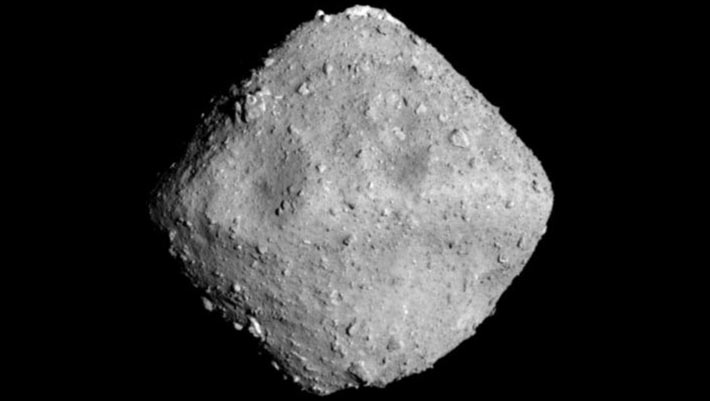Astronomical observations show that polycyclic aromatic hydrocarbons (PAHs) are abundant and widespread in the interstellar medium. PAH molecules consist of several adjacent aromatic rings terminated by hydrogens. In new research, scientists performed laboratory isotopic analysis of PAHs in samples of the asteroid Ryugu that were collected by JAXA’s Hayabusa-2 spacecraft as well as in samples of the meteorite Murchison. They argue that at least some of the Ryugu PAHs must have formed in cold interstellar clouds and thus predate the Solar System.
This image of the asteroid Ryugu was captured by the Optical Navigation Camera – Telescopic (ONC-T) on JAXA’s Hayabusa-2 spacecraft on June 26, 2018, from a distance of 13.7 miles (22 km). Image credit: JAXA / University of Tokyo / Kochi University / Rikkyo University / Nagoya University / Chiba Institute of Technology / Meiji University / Aizu University / AIST.
PAHs contain approximately 20% of the carbon in the interstellar medium.
They are potentially produced in circumstellar environments (at temperatures over 1000 K), by cold interstellar clouds (temperatures around 10 K), or by processing of carbon-rich dust grains.
“PAHs are organic compounds made up of carbon and hydrogen that are common on Earth but are also found in celestial bodies like asteroids and meteorites,” said study co-author Professor Kliti Grice, a researcher with the Western Australia Organic & Isotope Geochemistry Centre at Curtin University.
“We performed controlled burn experiments on Australian plants, which were isotopically compared to PAHs from fragments of the Ryugu asteroid that were returned to Earth by a Japanese spacecraft in 2020, and the Murchison meteorite that landed in Australia in 1969.”
“The bonds between light and heavy carbon isotopes in the PAHs were analyzed to reveal the temperature at which they were formed.”
“Select PAHs from Ryugu and Murchison were found to have different characteristics: the smaller ones likely in cold outer space, while bigger ones probably formed in warmer environments, like near a star or inside a celestial body.”

A model of the molecular structure of ribose and an image of the Murchison meteorite. Image credit: Yoshihiro Furukawa.
“Understanding the isotopic composition of PAHs helps unravel the conditions and environments in which these molecules were created, offering insights into the history and chemistry of celestial bodies like asteroids and meteorites,” said study co-author Dr. Alex Holman, also from the Western Australia Organic & Isotope Geochemistry Centre at Curtin University.
“This research gives us valuable insights into how organic compounds form beyond Earth and where they come from in space.”
“The use of high-tech methods and creative experiments has shown that select PAHs on asteroids can be formed in cold space.”
The results were published this week in the journal Science.
_____
Sarah S. Zeichner et al. 2023. Polycyclic aromatic hydrocarbons in samples of Ryugu formed in the interstellar medium. Science 382 (6677): 1411-1416; doi: 10.1126/science.adg6304




